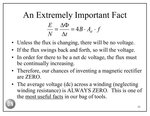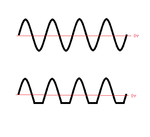neazoi
Advanced Member level 6
From this website (around the bottom) https://www.ibiblio.org/kuphaldt/electricCircuits/AC/AC_9.html
"saturable reactors tend to regulate AC power only in one direction: in one half of the AC cycle, the mmf's from both windings add; in the other half, they subtract. Thus, the core will have more flux in it during one half of the AC cycle than the other, and will saturate first in that cycle half, passing load current more easily in one direction than the other"
I am trying to benefit from this behaviour to built an "imperfect" diode using a saturable reactor, with no success yet.
Here is a diagram of what I am trying to experiment with. I have tried DC in one winding and 7MHz AC in the other. A few turns in both, at about 100mA to 1.5A max. I have used one of these tiny (1mm) computer memory square loop cores
Any ideas would be helpful.
"saturable reactors tend to regulate AC power only in one direction: in one half of the AC cycle, the mmf's from both windings add; in the other half, they subtract. Thus, the core will have more flux in it during one half of the AC cycle than the other, and will saturate first in that cycle half, passing load current more easily in one direction than the other"
I am trying to benefit from this behaviour to built an "imperfect" diode using a saturable reactor, with no success yet.
Here is a diagram of what I am trying to experiment with. I have tried DC in one winding and 7MHz AC in the other. A few turns in both, at about 100mA to 1.5A max. I have used one of these tiny (1mm) computer memory square loop cores
Any ideas would be helpful.


